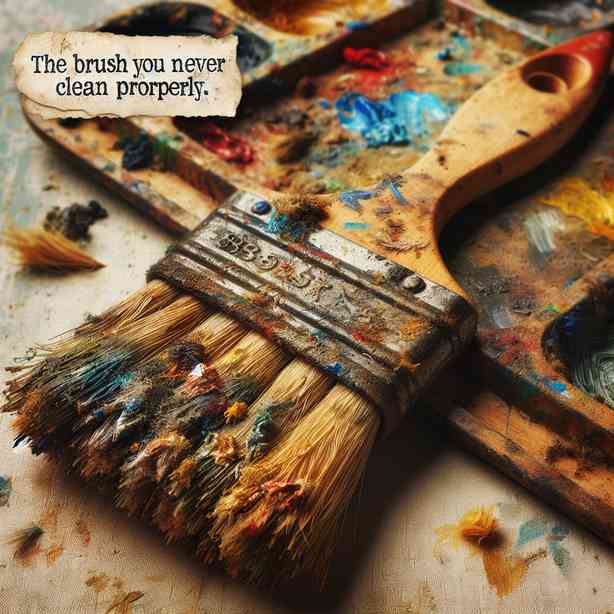
The brush you never clean properly can often represent a variety of everyday tools that we use but tend to neglect in terms of maintenance. This lack of care can lead to different consequences, particularly in how they perform and their longevity. Whether it’s a simple hairbrush, a paintbrush, or a cleaning brush, understanding the importance of cleanliness and proper maintenance is essential. In this article, we will delve into the various types of brushes we often use, the reasons why maintaining them is crucial, and provide practical tips on how to clean them effectively.
Let’s start with the first category, hairbrushes. Hairbrushes come in various styles and materials, such as plastic, wood, or metal, each serving a unique purpose. Regular use leads to the accumulation of hair, dust, and oils from your scalp. Neglecting to clean your hairbrush can result in less effective styling, as dirt and product buildup can create tangles and reduce shine. To clean your hairbrush, start by removing as much hair as possible. You can use a comb or your fingers to gently pull the hair out. Next, soak the brush in warm, soapy water for about 10-15 minutes. Use an old toothbrush to scrub the base and bristles gently, paying special attention to any buildup. Rinse thoroughly and let it air dry. Regularly cleaning your hairbrush enhances its performance and prolongs its lifespan, which is why it’s a small task worth incorporating into your routine.
Next, we have paintbrushes, essential tools for artists and DIY enthusiasts alike. Over time, paintbrushes can become caked with old paint, affecting their ability to hold paint correctly and produce a smooth finish. If you frequently clean your brushes, it helps maintain their bristles’ shape and flexibility, allowing for more precise strokes. After using a paintbrush, rinse it under warm water to remove excess paint. For oil-based paints, you may need a solvent, such as mineral spirits, to clean them effectively. For water-based paints, regular soap and water will usually suffice. After rinsing, reshape the bristles and lay them flat to dry to prevent them from becoming misshaped. Remember, a well-cared-for paintbrush can make a significant difference in your artwork or home projects.
Another type of brush that often falls into the category of those we neglect to clean properly is cleaning brushes. This includes various brushes used for cleaning, such as toilet brushes, scrub brushes, or even grill brushes. These tools play a vital role in household hygiene, yet they are often overlooked when it comes to maintenance. A dirty cleaning brush can spread germs and bacteria, negating the very purpose for which it was designed. For toilet brushes, regularly disinfecting them is crucial. You can soak the brush in a mixture of bleach and water for a few minutes, ensuring you follow safety guidelines while handling bleach. For scrub and grill brushes, rinsing them thoroughly after each use and occasionally soaking them in soapy water helps remove grease and grime. Keeping these brushes clean not only ensures effective cleaning but also contributes to a healthier living environment.
In addition to specific types of brushes, there are some general guidelines you can follow for all brushes to enhance cleanliness and maintenance. First, always store your brushes in a way that prevents them from becoming misshaped. For hair and paintbrushes, consider investing in a brush holder or case. For cleaning brushes, hanging them up or placing them in a designated section can prevent them from contacting dirty surfaces. Second, establish a regular cleaning schedule for your brushes based on how frequently you use them. By making brush cleaning a part of your routine, you’ll avoid extensive buildup that can be more challenging to remove later.
It’s also important to be mindful of the materials used in your brushes, as some brushes require specific cleaning methods to avoid damage. For instance, natural bristle brushes are more delicate than synthetic brushes and may require gentler cleaning solutions. Always read the manufacturer’s instructions when available to ensure you’re caring for your brushes correctly.
If you’re looking to go the extra mile, consider using eco-friendly cleaning products for your brushes. This moves you towards a more sustainable lifestyle while ensuring that your brushes are hygienically clean. Homemade solutions, such as vinegar and baking soda, can effectively clean a variety of brush types without the harsh chemicals often found in commercial cleaners. For example, a mixture of vinegar and water can help dissolve grime on paintbrushes, while baking soda can act as a gentle abrasive cleaner for scrub brushes.
In conclusion, the brushes we often neglect to clean properly play critical roles in our daily lives, whether we are styling our hair, working on art projects, or keeping our surroundings clean. Understanding the importance of maintaining these tools not only enhances their effectiveness but also contributes to a healthier and more efficient environment. By implementing simple cleaning routines and being mindful of the materials used in your brushes, you can ensure that they remain in excellent condition. Remember, a little care each time can go a long way in extending the life of your brushes and enhancing your daily experiences with them. Make it a habit to regularly clean your brushes, and you will undoubtedly reap the benefits in performance and longevity.


